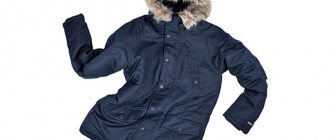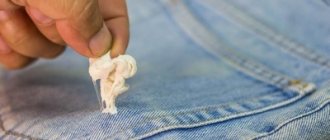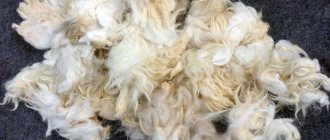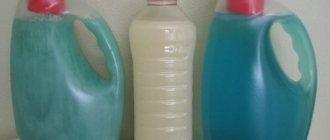I admit, I have not always found it easy to care for natural fabrics, because they quickly get dirty, wrinkle, and if not handled correctly, are short-lived and can shrink. Through trial and error, I found ways to extend the life of cotton materials. Do you want to know how to wash cotton without shrinking or stretching? I’m telling you - remember!
How to choose a detergent?
First of all, you need to choose the right detergent.
There are many powders, gels and liquids on sale now. You need to take those that are designed for washing cotton fabrics. They contain substances that soften water.
All of them also contain compounds that dissolve fat and protein stains on fabric. They usually work even in cold water. Detergents may contain surfactants, enzymes, and phosphates.
For cotton
. Optical or oxygen ones are best, they are safer for fabric. But such products are used only for white fabrics; colored linen must be washed with special powders, they must be marked “for colored linen”.
For children and people with allergies, you need to choose products with a special mark. They do not have a strong aroma and are easier to rinse out of fabric.
It is also important to choose the right form of detergent. The dosage, effectiveness, and application features depend on this:
- Powders are divided into products for hand and machine wash.
The latter are characterized by reduced foaming. For cotton, the powder is best used. Disadvantages include impracticality, complexity of dosage and poor dissolution in cool water. The most popular powders for cotton fabrics include: “Persil”, “Dosya”, “Aist”, “Sorti”, “Losk”.
Gel is more economical and safe.
It can be used at temperatures from 30. For washing delicate items, it is better to use gel, as it preserves the color and softness of the fabric. But it cannot be used at high temperatures. Wellery, Power Wash, Pigeon gels are the best to wash.- The capsules are used in the washing machine.
They are economical and dissolve well even in cold water. The capsules remove stains well and retain color, but have a strong aroma and are not recommended for use on children's laundry. It is worth paying attention to Persil Duo-Caps, Ariel Color 3 in 1, Tide 3 in 1 Pods Color, Losk Duo-Caps.
Some housewives use folk remedies for washing cotton the old fashioned way. Best for cotton:
- soda ash,
- salt,
- laundry soap.
Ammonia and hydrogen peroxide are used to remove stains.
It is not recommended to use chlorine-based bleaches. They damage the fibers of the fabric and can cause it to turn yellow.
Bleaching Cotton Fabric
There are many products for whitening clothes. Special means are selected for materials of different quality. To bleach in the washing machine, add ¼ cup of bleach. When treating yellowed laundry, increase the dosage of the product. For high-quality whitening, select the soak or pre-wash mode.
ARTICLE FOR YOU
How to wash interlock items: in the washing machine and by hand
Powder bleaches are selected according to the type of fabric. Read the instructions before use and pour the required amount of product into the plastic container of the machine. If you do not want to wash your clothes this way often, follow these recommendations.
Drying white clothes
Does cotton shrink when washed and why does this happen?
Cotton (cotton) is a natural material with increased strength, but in order for products made from this fabric to retain their original appearance, they must be handled correctly.
Why do things made from natural fabrics shrink not only as a result of being in the washing machine, but also after washing by hand? There are a number of reasons.
First of all, cotton shrinkage is determined by the characteristics of the fibers. The fact is that the raw material for the production of such fabrics is a fluffy mass reminiscent of cotton wool. As a result of twisting, loose threads are obtained, and under the influence of water, the fibers “stick together,” which leads to a decrease in their size. For this reason, dense cotton materials shrink the most, and the higher this indicator, the more the item will shrink after washing.
In addition, such fabrics can shrink if washed at high temperatures. For this reason, heating the water should not exceed 60 degrees so that the item does not decrease in size.
Having received the answer to the question of whether cotton shrinks when washed, it would be useful to find out how much the size of the item can change. Most often, the material is reduced by 5-6% in length and 2-3% in width.
How to dry and iron correctly
The fiber has good light fastness, but it is better to hang it in the shade after washing. This will prevent the fabric from fading. But drying in the cold is beneficial for the fabric. Freezing water particles straighten the fibers, restoring airiness and softness.
A special drying mode in the washing machine can shrink things.
You can iron cotton without impurities at maximum temperature, with or without a steamer. It is better to iron various fabrics according to the rules for caring for additional fiber.
Preparing cotton items for washing
A very important stage of washing is preparing things. This will help avoid deformation and discoloration. If you wash colored clothes together with light ones, they may fade.
Delicate items need to be taken away. They are washed separately at a temperature not exceeding 400.
Before putting cotton laundry into the machine, you need to do the following:
divide things by color, separate white linen (read about washing white linen here), separately colored linen;- sort them by degree of soiling; heavily soiled or stained items are washed separately;
- It is recommended to turn the clothes inside out, fasten all zippers and buttons, and empty the pockets;
- It is better to put small items in mesh bags; it is also recommended to wash duvet covers in them, this will prevent other laundry from getting inside;
- If the item is washed for the first time, you need to carefully study the label; it indicates at what temperature it should be washed, how to dry and iron it correctly.
More serious treatment is required for stained laundry. In order for them to wash off, it is recommended to remove them first. To do this, the item is pre-soaked for several hours.
We suggest you read How to descale a kettle with vinegar and baking soda
Before washing, you need to properly prepare cotton items:
- separate things by color;
- separate heavily soiled items from almost clean ones;
- check pockets and fasten all buttons and zippers;
- turn clothes inside out;
- look at the information on the labels about the recommended washing modes.
White cotton items should always be washed separately from colored items. The rest should be washed with items of a similar color.
However, white cotton clothes should not be washed together with white kitchen towels or old washed white clothes.
Drying
There is nothing complicated in the process of drying cotton, just do not forget to adhere to the main rule - do not overdry. When wet, the fabric smooths out perfectly. If your washing machine has a spin function at 1400 rpm, then after that you can immediately iron them.
If you need to dry your clothes, you must first smooth them out and shake them. This will help avoid creases and make the ironing process easier.
ARTICLE FOR YOU
How to properly wash staple clothes and linen: in a washing machine and by hand
If for some reason you forgot to take the clothes out of the machine after spinning, rinse them again, since being wrung out for a long time, the fabric cakes and is difficult to smooth out, even at high temperatures.
Cotton clothes are best dried on hangers, straightened and buttoned. Carry out the drying process in the shade so that light-colored items do not turn yellow and colored items do not fade.
Ironing cotton clothes
The nuances of the first wash
To ensure that cotton items retain their original appearance for a long time and do not shrink too much, it is important to carry out the first wash correctly. To do this, you must follow the following rules.
- Wash the item immediately after purchase, and not after a few days of use.
- Wash by hand.
- Use cold water without any detergent.
You will need to soak the clothes in a basin for 10-15 minutes, then rinse and send them to dry in fresh air, away from sunlight.
Subsequent washings can also be carried out in the machine, provided that the item is made of dense material. Thin fabrics will have to be tidied up only by hand.
Boiling
Thick white cotton items (such as dishcloths and towels) can be boiled to whiten or remove stains.
- To do this, use an enamel pan or basin.
- Pour water into a container, dissolve bleach in it (if necessary), put things in there and put on low heat.
- You can boil for 15-30 minutes.
- Then things need to be rinsed.
When washing cotton items, remember to carefully prepare and sort them. Pay attention to the type of weave, density, texture and color of the products. Also consider the manufacturer's recommendations when choosing a detergent and washing mode.
© 2021 textiletrend.ru
How to wash so that cotton items do not shrink?
Firstly, cotton items need to be sorted correctly. First, we divide things into undyed (or white) and colored. Further, all cotton is divided into categories:
- Thin cotton fabrics (chintz, tulle, muslin);
- Cotton fabrics are thick and durable (or, if available, homespun);
- Materials with a complex structure or pile (flannels, corduroy).
He is quite unpretentious. But the water temperature should be from 45 to 95 degrees. It is best to take oxygen bleaches (some products with chlorine are also acceptable). If you wash by hand, it is best to soak the dirtiest fabrics.
If you wash in a machine, you can set the spin cycle to maximum. As for drying, it is better to read the instructions for the item. Usually, cotton items are only slightly damp after such an active spin, so you can iron them immediately.
Color
The water temperature should be a maximum of 65 degrees. If the fabric is new, you can check to see if it will fade. Soak a corner of the material in hot water and soap and wipe it on a white, clean cloth. If there are traces of paint, it is better to wash such a thing by hand the first time. Other requirements include:
- Spin force – from 600 to 800 rpm;
- Washing mode – full;
- Rinse twice;
- Powder – without bleaches, for colored fabrics;
But it is better to dry such things not in a machine, but in the air.
There are several requirements here:
- Temperature – up to 60 degrees;
- Mode – delicate, washing time is not reduced;
- Rinsing is simple;
- Spin speed – maximum 600 rpm.
Using a tumble dryer is not recommended. Cotton lace is best washed by hand. Soak it in water with salt. Powder - depending on whether the fabric is colored or undyed. You don’t have to use a wringer, but simply wring things out with your hands. On lace and thin tablecloths, it is best to secure the design with pins and dry on the table.
Flannel and corduroy
You can wash such items only by hand (or according to the instructions in the instructions), temperature - up to 60 degrees. You can wash not only with powder, but also in a soap solution; it is recommended to use conditioner for cotton fabrics. Do not twist or wash. These types of cotton items can only be dried flat.
It is important not only to wash cotton items correctly, but also to dry them in accordance with the following recommendations.
- Hang products outdoors, away from sunlight.
- Try not to use clothespins, which can leave noticeable marks, but use hangers. If we are talking about bedding, you can simply throw it over a rope, folding it in half.
- When drying in a room, place cotton items away from radiators and heating devices.
You need to iron things made from natural fabrics as follows.
- Remove the slightly damp product from the rope, and if it has already dried, moisten it with a spray bottle.
- Lay out the clothes on a flat surface covered with thick bedding.
- Set the heat of the iron from 200 to 220 degrees.
- Iron the material by moving the device in the direction of the warp threads.
- Use the steam function.
You can iron cotton while it is wet, but in this case the heating of the iron should not be too high, otherwise scorch marks will appear on the surface of the fabric.
It happens that, despite all the efforts made, a cotton item still shrinks after washing. However, this is not a reason to part with your favorite shirt or T-shirt. Cotton, although slightly, stretches, and the problem can be solved in one of the following ways.
- Soak the product in warm water for an hour, and then wash it at 30 degrees, and, taking it out of the drum, gently pull it to the sides. After this, send the clothes to dry and periodically repeat the stretching manipulations.
- Soak a cotton item for 2 hours in a solution prepared in the proportion of 3 tablespoons of hydrogen peroxide per 10 liters of water, and then rinse thoroughly, stretching slightly, and dry in a horizontal position. You can replace peroxide with vinegar.
- Iron the clothes with a hot iron, using the steam function and slightly stretching the fibers to the sides.
We suggest you read: Is it possible to wash an anti-stress pillow?
So, by following the listed recommendations, you can prevent cotton clothes from shrinking during the washing process, and if this happens, solve the problem quickly and easily. Otherwise, when you need to “shrink” the product a little, it is enough to do the opposite: wash it at high temperatures and dry it in a horizontal position, covering it with terry cloth.
If you are not careful when processing cotton fabrics (for example, chintz, cambric, satin and others), they can:
- sit down (be subject to deformation);
- turn yellow;
- shed.
The material shrinks both in length and width. In order to properly care for such fabrics, you need to understand why their size changes.
The reduction in the original size of cotton is largely due to the structure of the fibers. The raw material for the production of the material is the fluffy mass of cotton fruits.
Textile threads are thoroughly stretched during the manufacturing process. When in contact with water and heat treatment, cotton fabrics swell, and when dried, they change length (shrink).
If decating was carried out correctly during production, the scale of shrinkage is much less. Decatation is the processing of textiles (wet-thermal) during the production process. Its purpose is to pre-shrink fabrics before cutting them.
The reason for shrinkage of cotton fabrics is often the incorrectly chosen washing (ironing) temperature.
Artificial fabrics, as a rule, are not prone to shrinkage, which is why adding them to cotton makes it more stable and elastic. Cotton with elastane (satin, stretch cotton, bengalene, gabardine, polyester) has increased stretchability.
When fibers are combined, the texture of the fabric becomes elastic, firm, and shrinks to a lesser extent. However, we must not forget about the temperature compliance when washing and ironing, determined by the product labels.
1 way
Prepare water. It should not be hot, about 30°C. Soak the “shrunken” item for an hour and a half. Wash it in a machine at the same temperature in the “delicate wash” mode.
After removal, gently squeeze the product and carefully stretch it by hand to the required size. The stretching process can be repeated several times.
During drying, if necessary, continue stretching the fabric to give it the desired shape and achieve the desired size.
Method 2
Another option for stretching the product is ironing with steaming (you can use thin damp gauze). During the ironing process, you should stretch the fabric with your hands in the desired direction. Cotton is thermoplastic, so fabrics made from it “remember” the shape they are given when ironed.
3 way
Rinse shrinked cotton products in water, which is diluted with hydrogen peroxide (2-4 spoons per 10 liters of water). While rinsing, constantly stretch the product. As an alternative, you can use vinegar. The effect is enhanced by repeated soaking and drying.
It happens that shrinking clothes, on the contrary, is necessary. In this case, you need to do the opposite: wash at high temperatures, use machine drying or drying in a horizontal position.
How to wash cotton items in the washing machine and by hand so that they do not shrink?
In the washing machine
The easiest way to wash cotton is in a washing machine; you just need to choose the right mode and temperature. To do everything right, you can use the step-by-step guide:
- Sort things by color and degree of soiling.
Place in drum.- Add the required amount of powder.
- Set the temperature from 40 to 90, spin speed 500-800 rpm.
Select “Cotton” or “Delicate Wash” mode. It must be remembered that cotton shrinks not only from high temperatures, but also from strong spinning, so it is recommended to select maximum values only for coarse fabrics and bed linen. - For laundry, it is recommended to rinse twice to completely remove the powder.
Manually
Hand wash delicate items, thin clothes and linen. For this purpose, you should not pour water with a temperature above 40.
The process of washing such things is not complicated:
- First, dissolve the laundry soap powder or shavings well in water.
- Dip the item into the solution and leave for 10-20 minutes.
- Rinse gently with your hands, trying not to rub or pull the fabric.
- Rinse several times to completely remove detergent.
- Add a little conditioner or vinegar during the final rinse. This will give things softness.
- Do not twist it too much, just squeeze it a little, then straighten it and hang it to dry.
Sometimes it is necessary to reduce stretched clothing. It is easy to “plant” cotton; you need to use a higher washing temperature.
In the typewriter
You need to wash the item in the machine at a temperature of 60, if it is white and made of thick fabric, you can even set it to 90.
For shrinkage, spinning at maximum speed and automatic drying are also used. It is carried out at high temperatures, so the cotton always shrinks after it.
Handwash
You can shrink the product by hand washing. During the last rinse, you need to pour boiling water into the basin and add a little fabric softener.
The item is dipped into the solution and covered with something, possibly film. After 5 minutes, transfer to cold water, rinse a little and squeeze.
It is not recommended to machine dry cotton. High temperature will cause shrinkage. Automatic drying is only suitable for coarse fabrics. They will have a special sign on their label: a square, a circle in it, and 3 dots inside.
If a crossed out triangle is drawn, it means that the item can only be washed gently. It is advisable to dry the rest naturally.
After finishing washing, the items are taken out of the drum and straightened out well. Then they are hung on a special drying rack or on a rope.
We suggest you read: Do I need to wash a blanket after purchase?
It is better not to dry cotton items in the bright sun: white ones may turn yellow, and colored ones may fade. It is better to lay out delicate items on a flat horizontal surface, straightening out all the folds.
During ironing, maximum temperatures can be set only for coarse fabrics, bed linen, and towels. For delicate ones, it is better to choose a different mode.
How to wash cotton items by hand?
After the item has been in use for some time, you need to wash it by hand as follows.
- Fill a basin with warm water, the temperature of which does not exceed 40 degrees.
- Add a tablespoon of grated laundry soap and wait until the composition dissolves. You can also use a special product designed for natural fabrics.
- Soak clothes in soapy water for 10-15 minutes, and then wash as usual.
Washing cotton items by hand
It is recommended to wash clothes made of thin lace and lightweight materials by hand. Here is a list of rules to follow:
- When washing by hand, avoid prolonged soaking and use non-aggressive detergents.
- To avoid deformation of the fabric, do not twist the garment too much.
- Wash products at 40C.
- Rinse in water at room temperature with added fabric softener. This will give the clothes softness and make them easier to iron after washing.
- For heavily soiled items, soak them briefly in hot water.
- The manual washing time is determined depending on the degree of soiling of the item. When the laundry is not very dirty, it is easy enough to rub it for a few minutes, then rinse and hang to dry.
ARTICLE FOR YOU
How to wash blackout items: in a washing machine and by hand
Washing cotton items in a washing machine
How and at what temperature should you wash cotton in a washing machine?
When automatically washing cotton, to prevent it from shrinking, you must follow the following rules.
- Study the recommendations indicated on the product tag.
- Inspect the material for stains and, if any, remove them before washing. To remove stains from white fabrics, you can use mild oxygen bleaches without chlorine.
- Sort items by color, wash white items separately.
- Sort clothes according to degree of soiling, and wash items that simply need to be refreshed on a gentle cycle.
- Place clothes or bedding in the drum after turning them inside out and fastening all zippers and buttons.
- Place small items in a special bag or an old pillowcase before loading the laundry into the machine.
- For dense fabrics, set a mode in which the water temperature does not exceed 60 degrees.
- Delicate materials should be washed at 40 degrees.
- For colored items, use detergents containing enzymes to prevent shedding.
- When using dry powders, install an additional rinse.
- Use a gentle spin and turn off the automatic drying function.
Why does the fabric shrink?
It should be taken into account that natural fabrics, including cotton, shrink at high temperatures. The optimal water for washing cotton products is water no hotter than 60 degrees. Before washing an item, you need to read the label, where the manufacturer indicates the processing conditions, drying, etc.
Important. Failure to follow simple rules for processing cotton material will, at best, lead to deformation and shrinkage; at worst, the item may fade or turn yellow. It is generally recommended to wash new items in cool water the first time.
How to remove blood, grease, and grass stains?
Heavily soiled or stained items should be pre-soaked. If the stains are ordinary, you need to dissolve a few spoons of powder in hot water, put the item in and leave it for a day. Some machines have a pre-wash or soak mode.
Stains are more difficult to deal with. To remove them, you can use industrial stain removers or folk remedies.
You can use one of the most common methods:
Dissolve 2 tbsp in 5 liters of hot water. any detergent for cotton washing. It is better to choose those that contain optical brightener or stain remover. Keep the item in the solution for at least 3 hours.- Dissolve a quarter of a bar of laundry soap in 5 liters of water. Grind it first. The solution is suitable for soaking delicate fabrics.
- If you add 9% vinegar to the saline solution, you can soak colored chintz and denim. Proportions for 10 liters of water 5 tbsp. vinegar and 3 tbsp. salt.
- Blood stains should be washed in cold water. Then lather with laundry soap and leave for half an hour.
- To get rid of greasy stains, apply a mixture of grated laundry soap, ammonia and turpentine to the fabric. Proportions 2:1:1.
- Clothes stained with grass should be washed with laundry soap. If that doesn’t help, pour hydrogen peroxide onto the stain and sprinkle baking soda on top. After this, rub a little with a soft brush.
- To remove stains from brilliant green, you need to rub the fabric with a solution of alcohol with lemon juice or ammonia.
How to bleach?
Only pure white items can be bleached. There is no need to boil them or soak them for a long time. Nowadays effective bleaches are produced, which are added with powder during washing. They help get rid of the yellow or grayish tint of old linen.
It is better not to use chlorine-containing products, as they damage the fabric. Oxygen or optical brighteners are just as good at removing stains. To increase efficiency, you can pre-soak the item in their solution.
You can return the whiteness of towels, tablecloths and linen with the following solution: add 1 tbsp per 10 liters. ammonia and 2 tbsp. hydrogen peroxide. You need to soak the item for 20-30 minutes.
A saline solution is suitable for handkerchiefs: 30 g of fine table salt per liter of water. This solution helps get rid of yellow sweat stains on white T-shirts or shirts.











